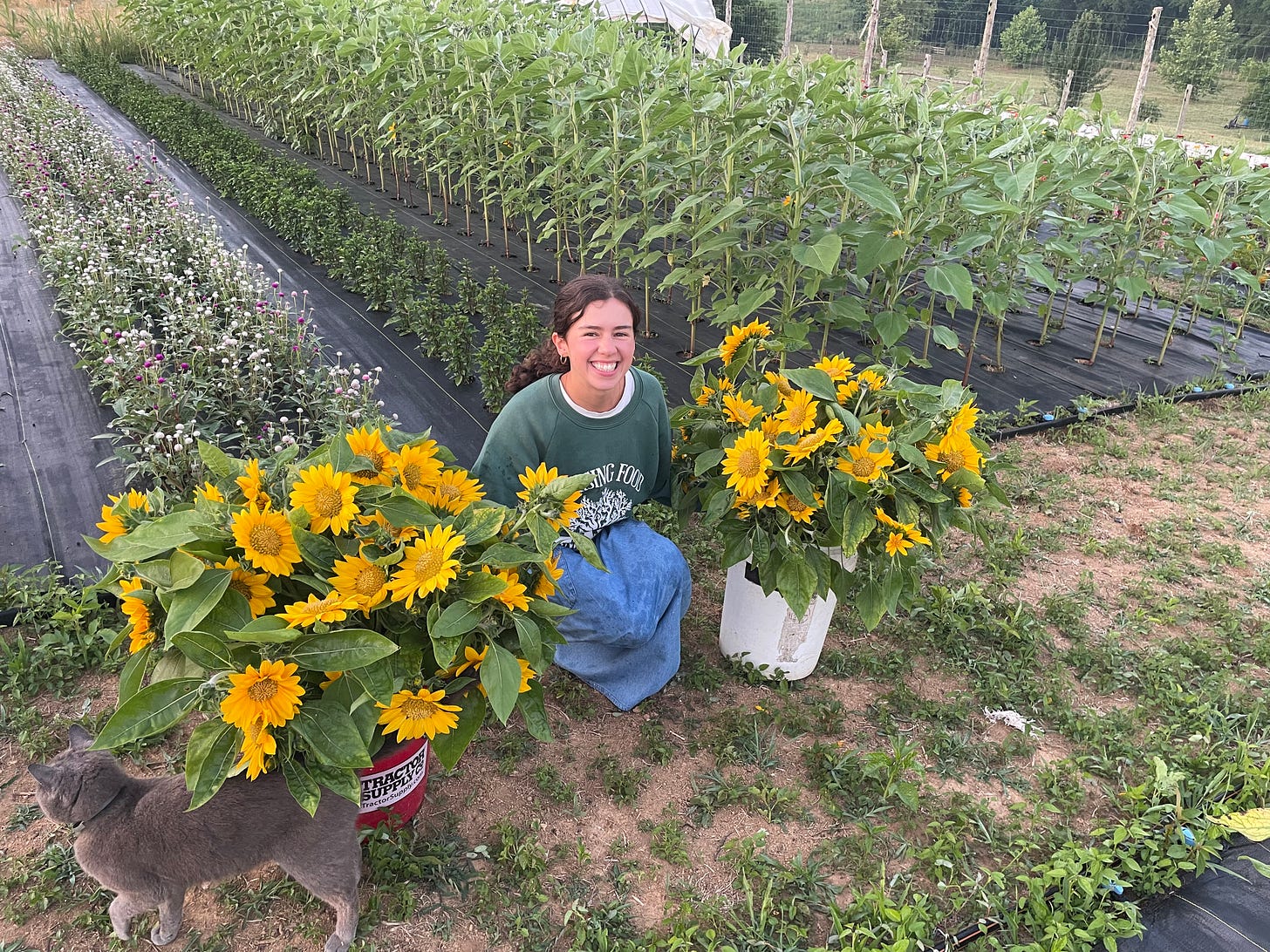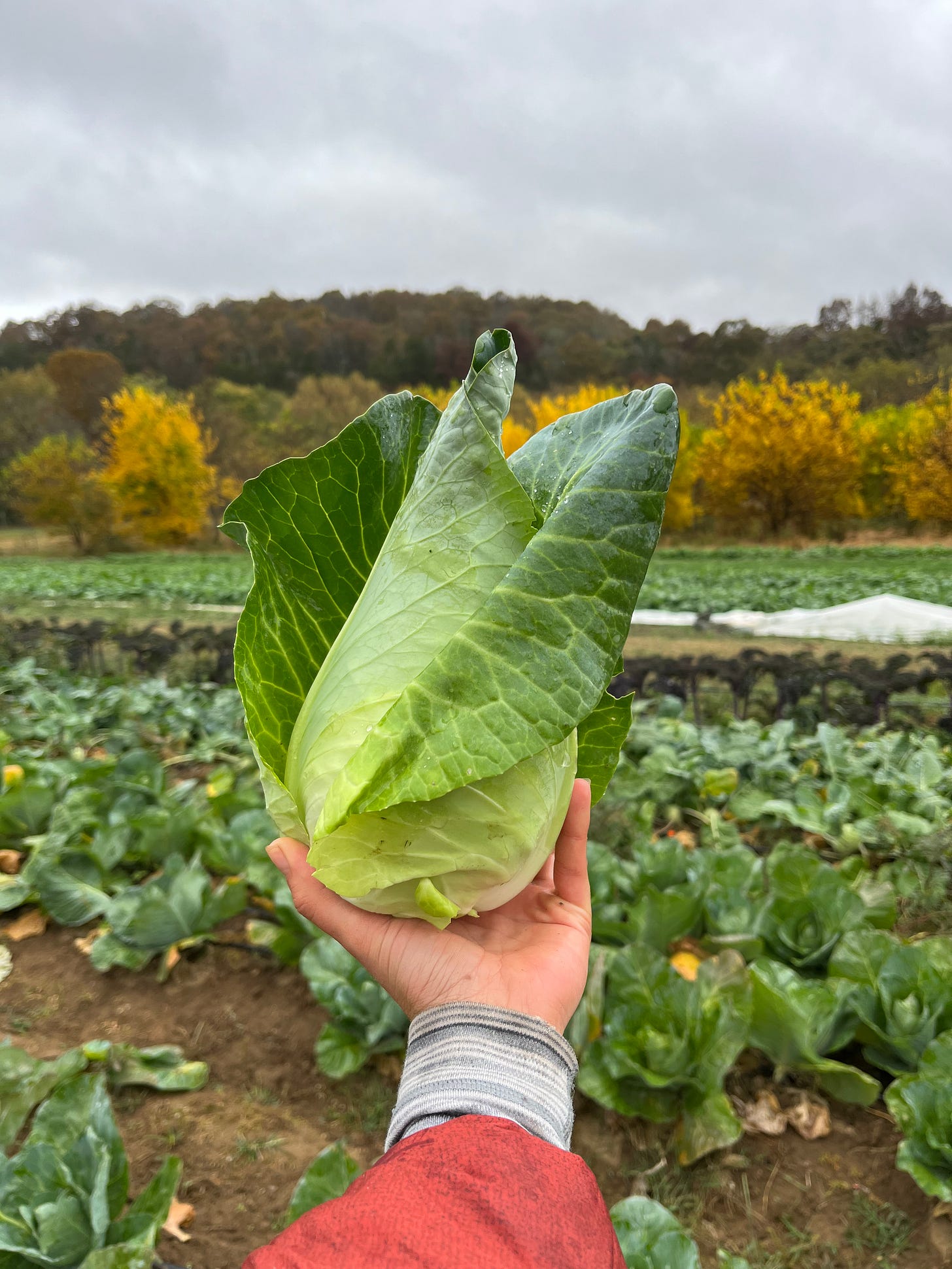Six months of regenerative farming and okonomiyaki
My beginnings as a regenerative farmer in Tennessee and my take on okonomiyaki- Japanese cabbage pancakes.
Since my consistent blogging, I’ve undergone a significant lifestyle change: that of a full-time, rural-living, regenerative farmer. At a farm in Tennessee, I've immersed myself in diverse seasons and tasks, to the extent that summarizing all my experiences seems incomprehensible. Nevertheless, what follows is my attempt to provide a glimpse into the past six months.
Summer
Beginning in June, my body and mind acclimated to the seemingly endless tasks of pepper, summer squash, and tomato harvesting, as well as the repetitive and ceaseless weeding. I devoted myself to watering plants amid days of fluctuating heat, experienced the excited buzz of the Nashville farmer’s market, and faced the always overloaded and unabated list of summer’s tasks. At home, I tried my hand at canning and preserving summer’s bounty, resulting in a freezer filled with tomato sauces and an untouched shelf of pickles (which I’m admittedly too afraid to eat due to the mystery of botulism). I cooked and baked with a passionate connection to the food at hand, sharing meaningful meals with roommates and co-workers. Most importantly, I warmed up to those I farm alongside, reaping farming knowledge, life advice, and recipes from kind, down-to-earth, inspiring folks. It was a beautiful first summer of farming which, to my surprise, gradually and here and there came to an end.
Fall
Instead of following a distinct seasonal pattern, fall felt like a period of erratic oscillations. Amid a spectrum of frosts and heat, we germinated winter crops in the greenhouse, cleared beds and tunnels of summer’s remnants, amended the soils, transplanted thousands of winter crops to their designated places, sowed cover-crops, collected underwhelming amounts of chestnuts (due to late spring frosts), unearthed sweet potatoes, and buried garlic cloves. Emerging from the extreme hustle and bustle of summer, I had the opportunity to attend a week-long course outside of Havana focused on campesino a campesino (farmer-to-farmer) methodologies for advancing agroecological practices. Connecting and collaborating with a global network of farmers, I gained insights into facilitating grassroots farmer-to-farmer exchanges. Back at home, it's no surprise that kitchen shenanigans were in full swing, with carrot cake, sweet potato bread, and apple muffins being commonly baked and enjoyed. While fall was undoubtedly a period of continuous daily learning, I also grew increasingly confident in farm tasks and felt more settled amid the familiar routines, people, and landscape.
Caraflex cabbage and okonomiyaki
In my initial weeks on the farm, my co-workers introduced me to caraflex cabbage, a conical variety known for its sweet and buttery taste. Having little prior experience with cooking cabbage, I sought their advice on its preparation and, armed with their recommendations, embarked on culinary experimentation. I came across a recipe for roasted cabbage with miso butter1, and ever since, I’ve been an unwavering caraflex cabbage devotee. I indulged in cabbage daily for weeks until it momentarily vanished from both the field and the fridge. Rather than lamenting its absence, I eagerly contributed to seeding approximately 30 trays of caraflex, what would become over 2,000 mature plants. Before I knew it, the beloved vegetable was back in my life.
Inspired by the local Nashville restaurant Xiao Bao, my new favorite way to enjoy caraflex is in an okonomiyaki-like style. Since okonomi translates to “to one’s liking”, I’ve had fun crafting my easy, tasty take on these Japanese cabbage pancakes. While the delicious, authentic pancakes features ingredients like seaweed, bonito flakes, eggs, and pork, I simplify it with whatever is on hand. Typically, I shred the cabbage and toss it with olive oil and salt on a baking sheet, and ensure its not too dense to allow for my preferred level of crispiness. Baking it at 450 F, I toss it at what I’ve intuited as half-way through, and remove from the oven when its crispy and slightly burnt. I plate it, drizzle with mayo and sriracha, and garnish with farm-fresh scallions. It couldn’t be more beloved to me.
While there’s currently little I love more than this dish, I must issue a warning for those that undertake to recreate it. My affection this vegetable is inevitably intertwined with the countless hours I’ve spent seeding, planting, watering, weeding, harvesting, processing, cooking, and sharing it. My experience affirms my belief that the utmost secret to any dish lies in the prerequisite relationship with the ingredients. So, perhaps a truer recipe is as follows:
Caraflex cabbage- to embark on the delightful journey of relational eating
Ingredients
Seeds: I’ve found them at Johnny’s and High Mowing. If you need help obtaining seeds, feel free to reach out to me :)
Healthy soil: perhaps at home, in community gardens, or in collaboration/as a trial with your very own local farmer. If you haven’t gardened before, I strongly recommend learning at first among others (more fun, less responsibility/ time commitment).
Sunlight: direct sow caraflex seeds when daytime soil temps warm to 75°F, or start indoors or in a greenhouse.
Water
Follow precise guidance based on your own hardiness growing zone
Enjoy!
Shredded cabbage tossed in olive oil and salt, roasted at 450 F until crispy and tender, and drizzled with melted miso butter.





Thank you for sharing this amazing dish with us! It is exactly as you describe it. Your love and passion shows up on each and every meal that you lovingly prepare. Pure Joy!!
Anna, thanks for providing this fun and enlightening, gentle read to start my Sunday. Long May you run!